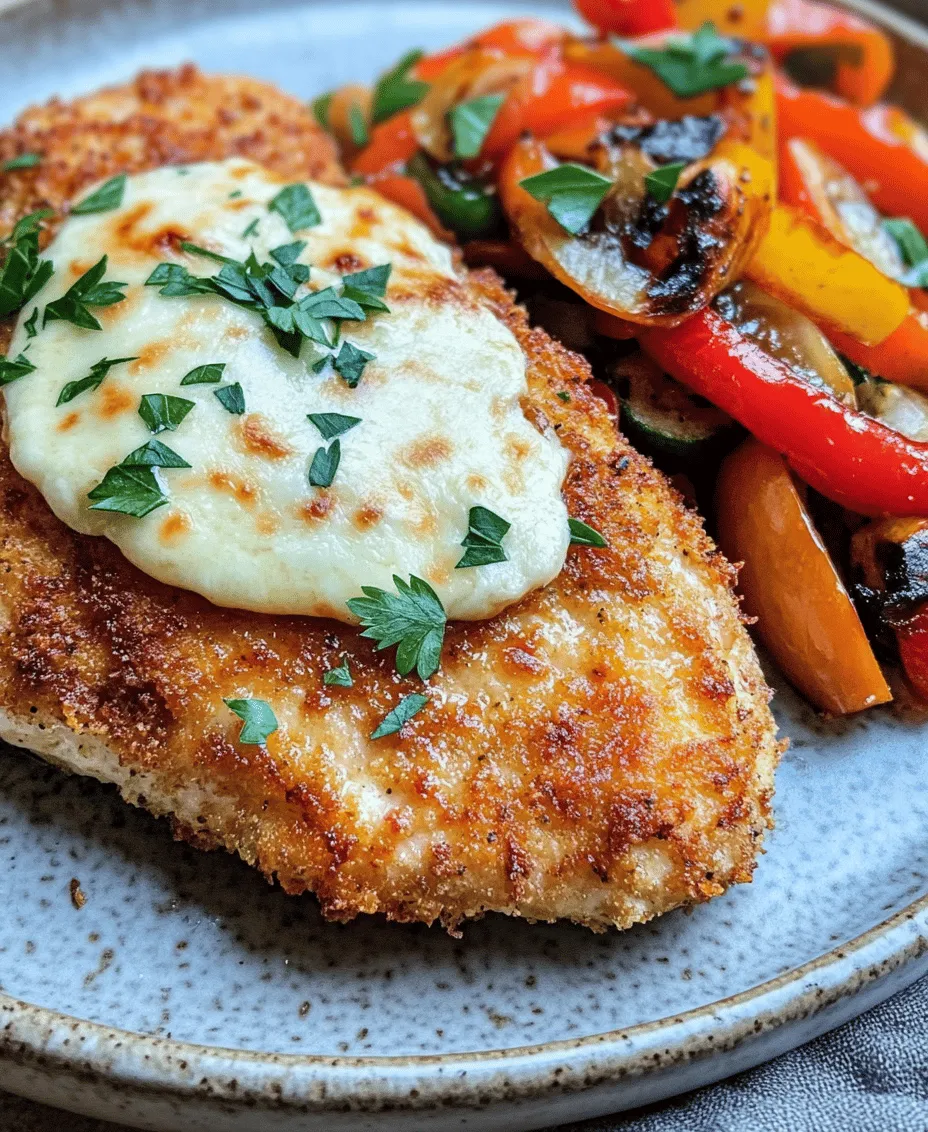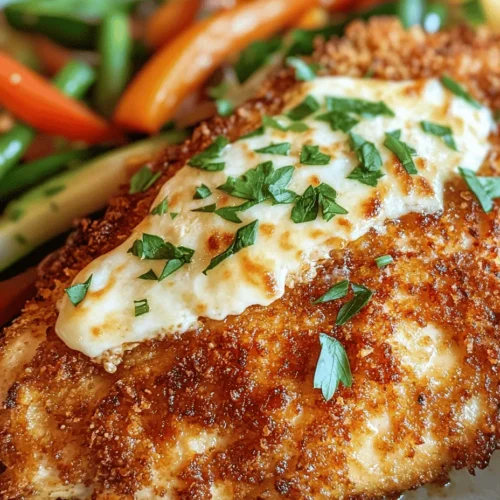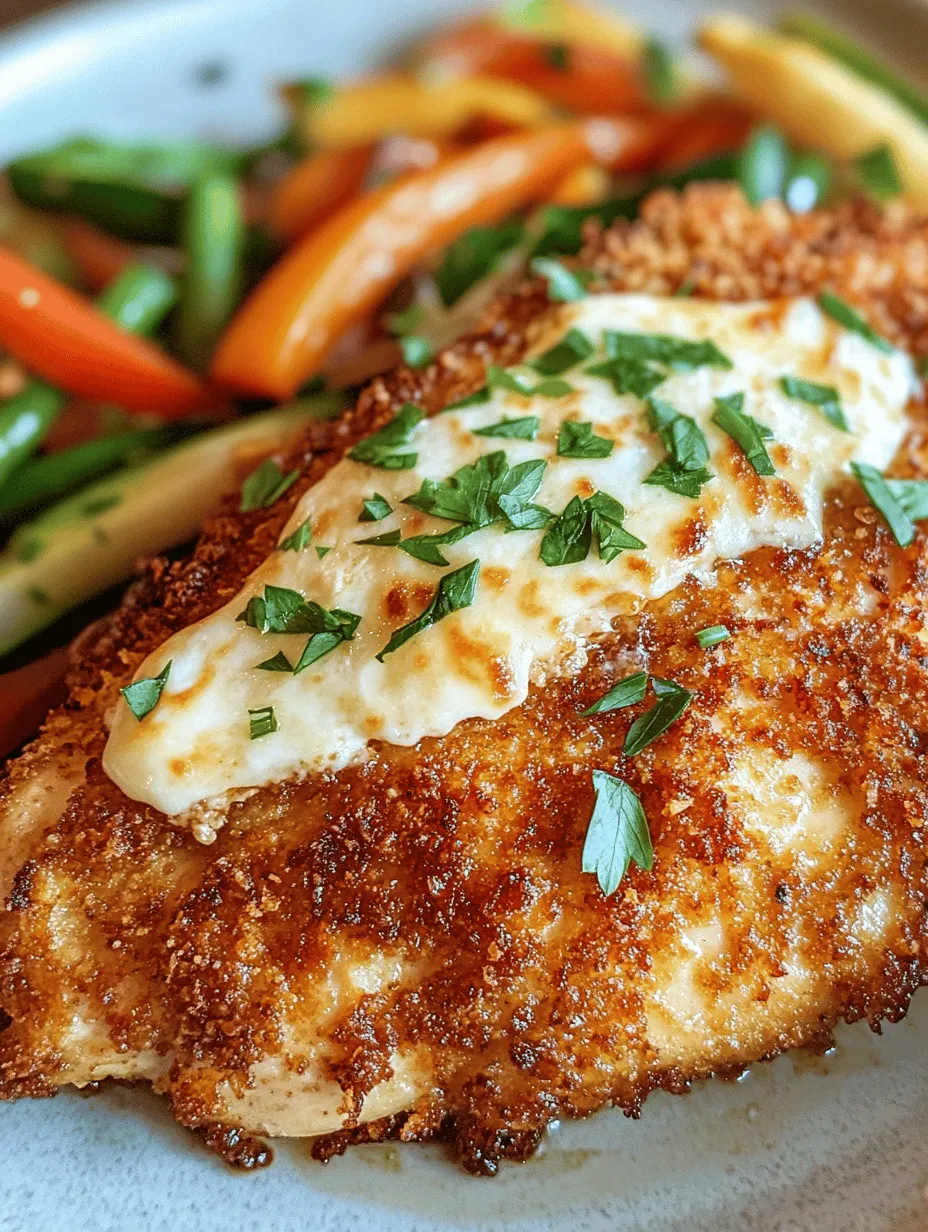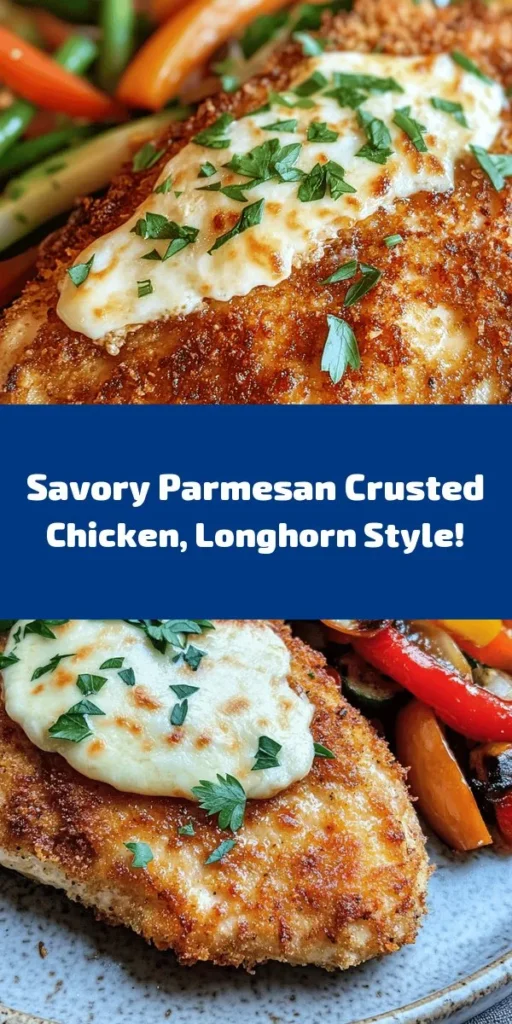Introduction
If you’ve ever dined at Longhorn Steakhouse, chances are you’ve savored their famous Parmesan Crusted Chicken—a dish that has left many diners craving more. This delectable recipe features tender chicken breast coated in a golden, crispy crust that’s both cheesy and flavorful. The combination of Parmesan and mozzarella cheeses creates a rich, savory experience that tantalizes the taste buds, making it a favorite among families and friends. As the popularity of crispy, cheesy chicken dishes continues to rise, it’s no surprise that many home cooks are eager to recreate this restaurant classic in the comfort of their own kitchens.
Recreating restaurant favorites at home not only allows you to enjoy the same mouthwatering flavors but also offers a sense of satisfaction in crafting a meal that can be customized to your liking. Whether you want to adjust the spice levels, swap out ingredients for healthier alternatives, or simply enjoy a night in with loved ones, making Parmesan Crusted Chicken at home is both cost-effective and fulfilling. In this article, we’ll explore the ingredients that come together to create this dish and guide you through the preparation steps to ensure your chicken is perfectly cooked and irresistibly crunchy.
Understanding the Ingredients
To create the perfect Parmesan Crusted Chicken, it’s essential to understand the role each ingredient plays in elevating the dish. From the chicken itself to the flavorful coating, every element contributes to the overall experience.
Chicken Breast
The star of this dish is, of course, the chicken breast. A lean source of protein, chicken breast is versatile and easy to work with. When cooked correctly, it remains juicy and tender, providing a delightful contrast to the crunchy exterior. For this recipe, boneless, skinless chicken breasts are preferred for their ease of preparation and ability to absorb flavors during marination.
Buttermilk
Buttermilk serves as a key ingredient in the marination process, transforming ordinary chicken into a tender, flavorful delight. The acidity in buttermilk helps to break down the proteins in the chicken, resulting in a moist and juicy texture. Additionally, buttermilk adds a subtle tang that enhances the overall flavor of the dish. If you don’t have buttermilk on hand, you can easily make a substitute by mixing milk with a splash of vinegar or lemon juice, allowing it to sit for a few minutes until it thickens slightly.
Seasoned Breadcrumbs
The next crucial component is the seasoned breadcrumbs. These breadcrumbs not only provide the essential crunch that makes this dish so appealing but also enhance its flavor profile. Seasoned breadcrumbs are typically pre-mixed with herbs and spices, ensuring that every bite is bursting with taste. If you prefer a homemade touch, you can make your own by blending plain breadcrumbs with Italian seasoning, garlic powder, and a pinch of salt.
Parmesan and Mozzarella Cheeses
Cheese lovers will appreciate the combination of Parmesan and mozzarella in this recipe. Parmesan cheese adds a sharp, nutty flavor that perfectly complements the chicken, while mozzarella contributes a gooey, stringy texture when melted. Together, these cheeses create a delicious crust that keeps the chicken moist and flavorful. Opt for freshly grated cheese whenever possible, as it melts more smoothly and provides better flavor than pre-shredded varieties.
Spices and Herbs
To elevate the flavor of your Parmesan Crusted Chicken, we incorporate a blend of spices and herbs, including garlic powder, onion powder, and Italian herbs. Garlic powder and onion powder enhance the savory notes, while Italian herbs—such as oregano and basil—impart a fresh, aromatic quality that pairs beautifully with the cheese and chicken. This combination of spices ensures that each bite is packed with flavor.
Olive Oil
Lastly, we can’t forget about olive oil—the oil of choice for frying in this recipe. Not only does olive oil add richness to the dish, but it also has health benefits compared to other cooking oils. Rich in monounsaturated fats, olive oil is known to promote heart health and has anti-inflammatory properties. It’s ideal for frying, as it has a relatively high smoke point, allowing the chicken to achieve that coveted golden-brown crust without burning.
Preparation Steps for Perfect Parmesan Crusted Chicken
Now that we’ve explored the essential ingredients, let’s delve into the preparation steps for creating this delicious Parmesan Crusted Chicken. Each step plays a crucial role in ensuring that your chicken is not only flavorful but also achieves the perfect crunch.
Step 1: Marinating the Chicken
Begin by marinating the chicken in buttermilk. This step is critical, as it infuses the meat with flavor and helps tenderize it. To marinate the chicken, place the boneless, skinless chicken breasts in a bowl or a resealable plastic bag and pour in enough buttermilk to fully submerge the chicken. For optimal results, allow the chicken to marinate for at least 30 minutes, or up to overnight in the refrigerator. The longer the chicken marinates, the more flavorful and tender it will become.
Step 2: Setting Up Your Breading Station
While the chicken is marinating, it’s a great time to set up your breading station. A well-organized workspace will make the process more efficient and enjoyable. You’ll need three shallow dishes: one for the buttermilk marinade, one for the coating mixture, and one for the seasoned breadcrumbs.
1. In the first dish, pour out any remaining buttermilk from the marinated chicken.
2. In the second dish, combine equal parts of flour and the coating mixture, which consists of a blend of Parmesan cheese, mozzarella cheese, garlic powder, onion powder, and Italian herbs. This mixture will help the breadcrumbs adhere to the chicken and add an extra layer of flavor.
3. In the third dish, place the seasoned breadcrumbs.
Step 3: Coating the Chicken
Once your chicken has marinated and your breading station is ready, it’s time to coat the chicken. Remove each piece of chicken from the buttermilk, allowing any excess to drip off. Next, dip the chicken into the coating mixture, ensuring it is fully coated. This layer of flour and cheese will help create a flavorful base for the breadcrumbs to stick.
After coating with the flour mixture, transfer the chicken to the dish containing the seasoned breadcrumbs. Press the breadcrumbs firmly onto the chicken to ensure an even coating. The goal is to create a thick, crunchy crust that holds up during cooking. Repeat this process for each piece of chicken, ensuring they are all well-coated.
Step 4: Frying the Chicken
With the chicken coated, it’s time to fry it to perfection. In a large skillet, heat a generous amount of olive oil over medium-high heat. You’ll want enough oil to cover the bottom of the pan and create an environment for frying. Once the oil is hot, carefully place the breaded chicken breasts in the skillet, ensuring not to overcrowd the pan. Fry the chicken for about 5-7 minutes on each side, or until the coating is golden brown and the chicken is cooked through. You can check for doneness by using a meat thermometer; the internal temperature should reach 165°F (74°C).
Step 5: Draining and Serving
Once the chicken is cooked, transfer it to a paper towel-lined plate to drain any excess oil. This step is crucial for maintaining that crispy texture. Allow the chicken to rest for a few minutes before serving, as this will help the juices redistribute throughout the meat.
As you prepare to serve your Parmesan Crusted Chicken, consider pairing it with a side of creamy mashed potatoes, a fresh garden salad, or steamed vegetables. The combination of flavors and textures will surely impress your family and friends, making your meal a memorable one.
By following these preparation steps, you’ll create a restaurant-quality Parmesan Crusted Chicken that rivals the dish from Longhorn Steakhouse. Stay tuned for the next part of this article, where we’ll delve into tips for achieving the best results and address common questions about this delicious recipe.

Parmesan Crusted Bliss: Longhorn Copycat Chicken
Dredging Process and Its Importance
The dredging process is a crucial step in creating the perfect Parmesan-crusted chicken. This technique involves coating the chicken pieces in a mixture of flour, eggs, and breadcrumbs, which helps to create a crunchy and flavorful crust. The first step is to season the flour with salt, pepper, and any additional spices you prefer, which will enhance the overall flavor of the dish.
When you dip the chicken in the seasoned flour, it acts as a base layer that helps the egg wash adhere better to the chicken. The egg wash provides moisture and helps the breadcrumbs stick during frying or baking. Finally, the breadcrumbs—preferably a mixture of panko and grated Parmesan cheese—give the chicken its signature crunch and rich flavor.
Proper dredging is essential not only for adherence but also for achieving a uniform coating. If the coating is uneven, some parts of the chicken may become overcooked while others remain undercooked. This can affect both the texture and flavor of the dish. Therefore, ensure that each chicken piece is thoroughly coated in flour, followed by the egg wash, and finally the breadcrumb mixture, pressing down gently to secure the crumbs.
Cooking Techniques for Optimal Flavor and Texture
Significance of Searing Before Baking
Searing the chicken before baking is a technique that elevates the flavor and texture of the dish. When you sear the chicken in a hot skillet, you create a beautiful golden-brown crust through the Maillard reaction, which enhances the overall taste. This step locks in the juices and prevents the chicken from becoming dry during the baking process.
To sear the chicken effectively, heat a couple of tablespoons of oil in a large skillet over medium-high heat. Once the oil is shimmering, add the dredged chicken pieces. Sear them for about 3-4 minutes on each side until they are golden brown. Make sure not to overcrowd the skillet; doing so can lower the temperature of the oil and prevent proper browning.
Best Practices for Frying Chicken
Frying chicken can be a daunting task, but with the right techniques, you can achieve perfectly cooked chicken every time. Here are some essential tips:
– Heat Levels: Maintain a temperature between 350°F to 375°F. If the oil is too hot, the breadcrumbs may burn before the chicken cooks through. Conversely, if it’s too cool, the chicken will absorb excess oil and become greasy.
– Oil Quantity: Use enough oil to cover the bottom of the skillet adequately, about 1/4 inch deep is sufficient for frying. This depth allows for even cooking and browning.
– Timing: Cook the chicken for 4-5 minutes on each side, depending on thickness. Take care not to flip them too soon; they should release easily from the pan before turning.
Knowing When Chicken is Perfectly Cooked
To ensure your chicken is perfectly cooked, invest in a reliable meat thermometer. Insert the thermometer into the thickest part of the chicken without touching the bone. The internal temperature should reach 165°F for safe consumption. This step is crucial not only for food safety but also for maintaining moisture in the chicken.
Benefits of Baking After Frying
After frying, transferring the chicken to the oven allows for thorough cooking while ensuring a crispy exterior. Preheat your oven to 400°F, and place the seared chicken on a baking sheet lined with parchment paper. Bake for about 10-15 minutes, or until the internal temperature reaches 165°F. This method helps the chicken retain its moisture while the coating crisps up beautifully, giving you that restaurant-quality crunch.
Serving Suggestions and Pairings
To elevate your Parmesan-crusted chicken experience, consider the following side dishes and accompaniments:
– Side Dishes: Pair the chicken with a fresh garden salad dressed with a light vinaigrette, roasted vegetables, or creamy mashed potatoes. For a lighter option, steamed green beans or asparagus make excellent choices.
– Sauces and Dips: Enhance the dish with a side of marinara sauce for dipping or a creamy garlic aioli. A zesty lemon butter sauce can also complement the flavors beautifully.
– Presentation Tips: Make your dish visually appealing by arranging the chicken on a platter with a sprinkle of fresh parsley or basil. Serve with lemon wedges on the side for a pop of color and an extra burst of flavor.
Nutritional Information and Considerations
Understanding the nutritional profile of your meal can help you make informed choices. Here’s a breakdown of the nutritional values per serving:
– Calories: Approximately 400-450 calories
– Protein: 30-35 grams
– Fat: 20-25 grams (depending on oil used)
– Carbohydrates: 20-25 grams
Healthier Alternatives and Substitutions
If you’re looking for healthier alternatives, consider the following substitutions:
– Gluten-Free Options: Use almond flour or a gluten-free breading mix instead of traditional flour and breadcrumbs to cater to gluten sensitivities.
– Dairy-Free Adjustments: Substitute the Parmesan cheese with nutritional yeast or a dairy-free cheese alternative for a similar flavor profile without the dairy.
Considerations for Dietary Restrictions
Always consider your guests’ dietary restrictions. If you’re serving a group, it’s thoughtful to provide an option that accommodates various preferences, ensuring everyone can enjoy the meal without concern.
Conclusion
Creating your own Parmesan-crusted chicken at home is not only rewarding but also allows you to enjoy a restaurant-quality dish without leaving your kitchen. The satisfaction of mastering essential cooking techniques, from dredging to frying and baking, will leave you feeling accomplished.
Sharing this delicious meal with family and friends can create a memorable dining experience filled with laughter and joy. Don’t hesitate to experiment with flavors and ingredients—add your signature touch by incorporating different herbs, spices, or sides to make this dish uniquely yours.
So, gather your loved ones, prepare this delectable chicken, and enjoy the pleasure of good food and great company. Happy cooking!



